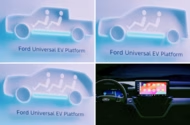What Makes Ford’s New Affordable EVs Such a Big Deal?
If you’ve been watching the electric vehicle (EV) space, you know it’s been a wild ride—especially when it comes to price tags. Ford’s latest announcement is shaking things up in a way that’s hard to ignore. They’re rolling out a brand-new line of affordable EVs, starting with a mid-size pickup truck in 2027, and the buzz is real. But what’s behind all the excitement? Let’s break it down.
How Will Ford’s Universal EV Platform Change the Game?
You might be wondering, what’s so special about this new platform? Ford’s calling it the Universal Electric Vehicle Platform, and they’re not shy about its impact. Company CEO Jim Farley even compared it to the Model T era—a bold claim, but not without reason.
The platform is the result of a three-year development sprint, designed from the ground up to support a range of vehicles, not just one-off models. This means Ford can build pickups, crossovers, and SUVs on the same foundation, slashing production costs and, crucially, sticker prices. The first model—a pickup truck—is set to launch at around $30,000 (roughly £22,000). For context, that’s significantly less than Ford’s current cheapest EV, the Puma Gen-E, which starts at nearly £30,000 in the UK.
Why Is Affordability Suddenly Front and Center?
Let’s face it: EVs have a reputation for being pricey. According to Kelley Blue Book, the average price of a new EV in the US hovered around $55,000 in 2023. That’s a tough sell for many families, especially with inflation and interest rates where they are. Ford’s move to bring a $30,000 electric pickup to market isn’t just about undercutting rivals—it’s about making EVs accessible to a much broader audience.
This shift matters, especially in the US, where EV adoption has lagged behind Europe and China. A recent Pew Research Center study found that while interest in EVs is growing, cost remains the number one barrier for most Americans. Ford’s new platform could be the nudge that tips the scales.
What Models Can We Expect—and Where Will They Be Built?
Ford’s not stopping at just one vehicle. After the pickup, expect a crossover and a three-row SUV, both likely to start at similar price points. All of these will roll out of Ford’s Louisville, Kentucky plant, which is getting a $2 billion overhaul to support EV production. Farley’s “from Kentucky to the world” mantra hints at global ambitions, so don’t be surprised if these models hit roads far beyond the US.
There’s also talk that the first pickup could revive the Ranchero name—a nod to Ford’s tradition of breathing new life into classic badges like Capri and Explorer for their EV lineup. It’s a clever move, tapping into nostalgia while signaling a new era.
How Will These EVs Stack Up on Performance and Features?
While Ford’s keeping most technical details under wraps for now, they’ve dropped some tantalizing hints. The new pickup is promised to be “faster than a Mustang twin-turbo”—that’s no small feat. Range is described as “amazing,” and Ford claims the truck will be able to power a house for up to six days, a feature that’s becoming increasingly relevant as extreme weather events and power outages become more common.
Fast charging is also on the menu, along with an operating system that supports over-the-air updates. This means your vehicle can get smarter and more capable over time, much like a smartphone. And for families or anyone who values space, Ford says the interior will be roomier than a Toyota RAV4—the best-selling SUV in the US.
What Does This Mean for the EV Market and Everyday Drivers?
Ford’s approach could be a turning point for the industry. By focusing on affordability, versatility, and real-world utility, they’re addressing the pain points that have kept many drivers on the EV sidelines. The ability to power your home, enjoy rapid charging, and not feel cramped inside—all at a price that doesn’t break the bank—could make EVs mainstream in a way we haven’t seen yet.
It’s also worth noting that Ford is positioning these models to compete directly with other up-and-coming electric trucks, including those backed by major tech players. The competition is heating up, and that’s good news for consumers—more options, better features, and (hopefully) lower prices across the board.
Looking Ahead: Is This the Tipping Point for Affordable EVs?
We’re at an inflection point. Ford’s new EV platform isn’t just about one truck or SUV—it’s about changing how we think about electric vehicles altogether. By investing heavily in US manufacturing and aiming for global reach, Ford is betting big on a future where EVs are the default, not the exception.
For drivers, this means more choices, better value, and a real shot at joining the electric revolution without emptying your wallet. The next few years will be telling, but one thing’s clear: the race to make EVs affordable for everyone just got a lot more interesting.

